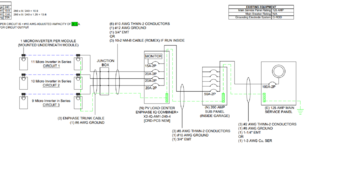So I'm barely in the finishing stage of my 9.45kW AC / 8.7kW DC Enphase IQ8+ setup, and I already want to start expanding...
I've got 20 panels up on the roof, should have the remaining 10 up soon.
This is what the setup looks like currently:

Here's the wrinkle: NEM 2.0 closed back in April last year (this plan was submitted before then, and got in). Any additions would kick me to NEM 3.0, which sucks (except adding batteries -- that's ok).
Question #1: My understanding is adding <10% / 1kW is doable while staying on NEM 2.0. Anyone actually done this? Did it require an entire new plan set / AHJ / PGE inspection?
Adding batteries is the obvious other idea (and can be done under NEM 2.0), although I've got plenty of additional roof to add panels on... Assuming I want to add panels, off-grid sounds like the only practical / PGE-legit way of doing it.
If I do add off-grid, that sounds like I then need to have dedicated batteries. It also sounds like I'd have to figure out some way of either semi-permanently segregating some loads to that off-grid panel (EV / hot water maybe?), or figure out some sort of ATS system.
On to my crazy plan:

What the heck is going on here?
All the stuff in red is "new".
Basically:
I'd add as many new solar panels as I feel like, plus an off-grid AIO, plus a bunch of cheap LFP cells / EG4 server batteries, etc. This off-grid system would charge up the huge cheap non-UL batteries until they're fully charged. At this point, the ATS would be triggered, and they'd start dumping into the new "off grid" sub panel + Encharge 5P battery until it's charged.
At that point, the ATS goes back into the normal position (IQ battery 5P --> Rest of house), and that discharges, while the Huge DIY battery starts charging from the off grid solar again.
This is janky, I know.
Limitations I can see:
1. Lots of cycles of the IQ Battery
2. Lots of wastage going from Offgrid PV -> 48 V battery -> 120 V -> IQ Battery DC, then when switched over, IQ Battery DC -> AC -> House loads.
3. Cost. Off grid PV (6kW / $2000?) + AIO (6kW / $1300?) + Cheap DIY battery (cheap 15x EVE LF304 , <$2000 15kWish) + IQ Battery ($3300)+ Extra IQ Gateway ($700). Total $10k or so.
Question #2: Do off-grid battery installs in california require them to be UL 9540?
I'm open to other suggestions that are less janky that don't lose my NEM 2.0 status...
I've got 20 panels up on the roof, should have the remaining 10 up soon.
This is what the setup looks like currently:

Here's the wrinkle: NEM 2.0 closed back in April last year (this plan was submitted before then, and got in). Any additions would kick me to NEM 3.0, which sucks (except adding batteries -- that's ok).
Question #1: My understanding is adding <10% / 1kW is doable while staying on NEM 2.0. Anyone actually done this? Did it require an entire new plan set / AHJ / PGE inspection?
Adding batteries is the obvious other idea (and can be done under NEM 2.0), although I've got plenty of additional roof to add panels on... Assuming I want to add panels, off-grid sounds like the only practical / PGE-legit way of doing it.
If I do add off-grid, that sounds like I then need to have dedicated batteries. It also sounds like I'd have to figure out some way of either semi-permanently segregating some loads to that off-grid panel (EV / hot water maybe?), or figure out some sort of ATS system.
On to my crazy plan:

What the heck is going on here?
All the stuff in red is "new".
Basically:
I'd add as many new solar panels as I feel like, plus an off-grid AIO, plus a bunch of cheap LFP cells / EG4 server batteries, etc. This off-grid system would charge up the huge cheap non-UL batteries until they're fully charged. At this point, the ATS would be triggered, and they'd start dumping into the new "off grid" sub panel + Encharge 5P battery until it's charged.
At that point, the ATS goes back into the normal position (IQ battery 5P --> Rest of house), and that discharges, while the Huge DIY battery starts charging from the off grid solar again.
This is janky, I know.
Limitations I can see:
1. Lots of cycles of the IQ Battery
2. Lots of wastage going from Offgrid PV -> 48 V battery -> 120 V -> IQ Battery DC, then when switched over, IQ Battery DC -> AC -> House loads.
3. Cost. Off grid PV (6kW / $2000?) + AIO (6kW / $1300?) + Cheap DIY battery (cheap 15x EVE LF304 , <$2000 15kWish) + IQ Battery ($3300)+ Extra IQ Gateway ($700). Total $10k or so.
Question #2: Do off-grid battery installs in california require them to be UL 9540?
I'm open to other suggestions that are less janky that don't lose my NEM 2.0 status...


